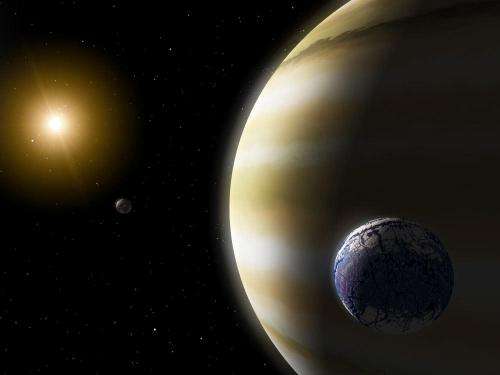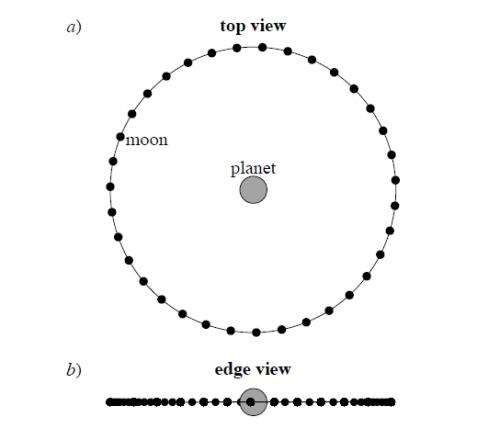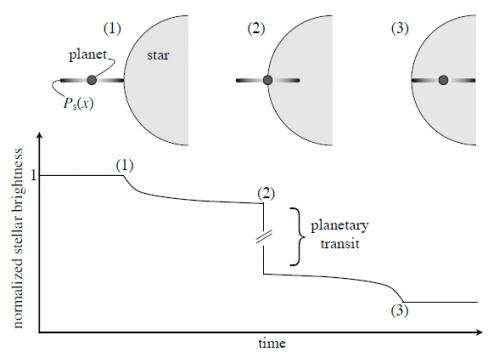New exomoon hunting technique could find solar system-like moons

Among the most sought-after prizes in astronomy these days are "exomoons," or moons orbiting exoplanets. Although astronomers have detected more than a thousand exoplanets, any exomoons they might harbor have so far eluded capture. However, judging by our own Solar System, where moons greatly outnumber planets, scientists believe that hordes of exomoons are indeed out there.
To find these exomoons hiding in plain view, a new technique has just been proposed. Described in a study recently accepted in The Astrophysical Journal, the new approach relies on a particular eclipsing effect of moons when viewed against the background radiance of their host stars.
Unlike traditional exomoon hunting techniques, the new method has the advantage of being able to find natural satellites on the scale of the moons here in the Solar System. Other methods can probably only yield exomoons several times the mass of the biggest moon known, Jupiter's Ganymede—in other words, unprecedentedly monstrous moons.
"This technique is the first method that has been demonstrated to allow detection of moons akin to those in the Solar System," said study author René Heller, a postdoctoral fellow in astronomy at McMaster University, in Ontario, Canada. "Four hundred years after Galileo Galilei discovered four moons orbiting Jupiter, the first moons we knew of besides our moon, we now have the technologies and methods available to go find 'alien' moons beyond our Solar System."
Additionally, the new method can distinguish multi-moon systems, whereas standard techniques focus on solo exomoons. A third benefit is that existing data from the Kepler spacecraft should suffice for identifying exomoons. That's in contrast to some other proposed methods which would require new technologies and force exomoon hunters to await future generations of telescopes.
Intriguingly, the method could tease out the presence of exomoons orbiting planets in the so-called habitable zones of red dwarf stars and orange dwarfs. The habitable zone is the not-too-close, not-too-far-away band around a star wherein residing worlds could have liquid water.
To date, the most common planets found in habitable zones are not Earth-sized (though a substantial number of earthly twins could emerge from Kepler data yet to be analyzed). Rather, habitable zone-dwellers are often "super-Earths" and gas giants. The latter certainly, and some have argued the former, cannot serve as abodes for life. But their moons could be a different story.
"Super-Earths and giant planets have been observed to be much more abundant in the stellar habitable zones than truly Earth-sized planets," said Heller. "While super-Earths and giants may not be habitable, their moons might be. Hence, habitable moons may be much more common than habitable planets."

Scouring for exomoons in a new way
The new technique comes at a good time. Researchers have already thrown the proverbial kitchen sink at the problem of exomoon catching, trying out about a dozen different methods without a confirmed detection. Some methods include looking for the tiny amount of infrared light a giant, hot exomoon emits, or a one-off, gravitational-light-warping effect of a background star's light as a planet and its moons pass in front of the star.
The concept behind the new method, observing "transits," is not in of itself new. Spotting transits, the mini-eclipses caused when an exoplanet (or an exomoon) crosses the face of its star respective to our viewing angle here on Earth, has been used to find hundreds of exoplanets with Kepler, CoRoT and other telescopes. A prominent exomoon-finding project, Hunting Exomoons with Kepler (HEK), as well as other efforts, seeks slight variations in transit timings or durations. These hiccups to an orderly, planetary transit might be the handiwork of a moon blocking out just a little extra starlight.
What the new method, called the orbital sampling effect, does is consider these exomoon transits from a clever statistical perspective. Picture a planet and moon system viewed edge-on in silhouette, where the moon orbits around the planet's equatorial midline (as is typical in the Solar System). The moon orbits in "front" of the planet, slightly nearer to us, and then completes the orbital circle behind the planet.
Imagine taking a snapshot every now and then of this setup and superimposing the pictures. The moon's positions in the front and back of the orbit overlap, though where the moon is directly in front of or behind the planet, the moon's shadow is not seen. What the moon does form, though, looks like two "wings" sticking out of the planet's sides, made up of dotted lines. The dots represent the moon's position at any particular, random moment as it progresses through its orbit.
The insight Heller had is that the dots in the wings will not appear evenly plotted over time. The wings will look lighter at their inner edges, nearer the planet, and darker at their outer edges, farther from the planet. That's because when the moon reaches the extent of its orbit and then starts circling back around the planet, its positions overlap more in a tighter space. As such, the "wingtips" look darker; that is, there is increased eclipsing of background starlight at the moon's farthest apparent positions from the planet.
For this effect to emerge, an observer must stare at a star constantly over a significant period of time. The moon cannot be glimpsed once or twice in isolation. Instead, the moon must complete quite a number of orbits, and be witnessed doing so, in order for its light-blocking effect to preferentially stack up at the wingtips. Fortunately, the Kepler spacecraft was designed to do just this, having patiently stared at around 150,000 stars for four years before suffering an equipment failure last summer.
"Such observations have already been taken by Kepler, and they are publicly accessible," said Heller. "So there's no need to wait for future technology."

One moon or many
When an exoplanet transits a star as seen by Kepler or another transit-registering telescope, there occurs a single drop in the amount of starlight received (only around a thousand parts per million for a gas giant planet). Using the orbital sampling method with Kepler data, averaged over time, the signature of an exoplanet sporting an exomoon would look like as follows.
First, there would be two small dips in the amount of light collected, one preceding and one following the comparatively much bigger dip in light by the host planet as the transit gets under way. This initial sequence is small dip, big dip, then an additional small dip. The sequence then reverses itself, with a slight lightening, followed by a relatively big increase in illumination, and a final small increase in the star's brightness as the planet and moon combo, averaged-over-time, emerges from the transit. In other words, small bump, big bump, and a final small bump in brightness.
The upshot of all this: astronomers (or computers) can look through Kepler data for the tell-tale "pre-darkening" and "post-darkening" of an exoplanet's regular transit to discover an exomoon.
As a bonus, the orbital sampling method can pick out multiple moons. Rather than the simple step-wise darkening just described for one moon, complex steps could point to more than one moon adding in its own, additional shadowy signature shifted in time.

What it might find
Based on the data collected by Kepler, Heller's study shows that moons about the size of Ganymede should be findable in the habitable zone of red dwarf stars. The advantage with small stars is that their planets have short orbits, with "years" lasting only weeks or days. Accordingly, these worlds racked up a lot of transits over Kepler's operational lifetime. More transits, of course, mean more exomoon positioning data for review with the orbital sampling method.
Red dwarf stars present some habitability issues, so better candidates for illuminating life-friendly worlds are the next stellar class up—the bigger, warmer orange dwarfs. In these stars' habitable zones, the Heller technique could potentially discover exomoons about ten times Ganymede's mass (but still smaller than Earth), which are the traditional quarry for current exomoon hunting methods, again using Kepler observations.
Unfortunately, moons around exoplanets in the habitable zones of still bigger and hotter Sun-like, yellow-dwarf stars will still remain unobtainable. Exoplanets revolving around stars like the Sun did not pile up enough transits in the Kepler observation window to apply the orbital sampling method. However, future telescopes with sharper cameras will give a leg-up to other exomoon-seeking techniques and will also provide Heller's method a boost in sensitivity.
The orbital sampling effect is much simpler than the elaborate exomoon detection mechanisms developed by other teams. Heller hopes that fellow researchers might go and try his technique to find extrasolar satellite systems.
"This paper was not planned to serve my own ambitions towards an exomoon detection," Heller said. "But if someone uses this new effect to find a moon outside the Solar System, I'd feel flattered."
Journal information: Astrophysical Journal
Provided by Astrobio.net











.jpg)









